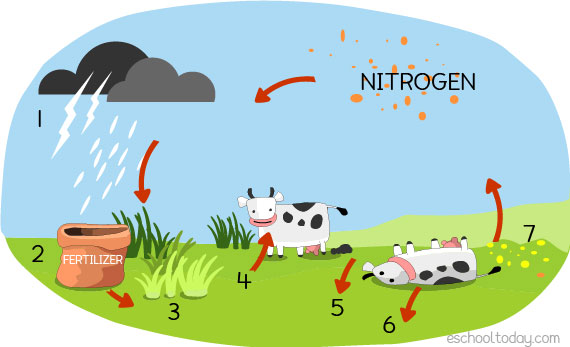- Ecosystems
The Nitrogen Cycle
Nitrogen is also key to the existence of ecosystems and food chains. Nitrogen forms about 78% of the air on Earth. But plants do not use nitrogen directly from the air. That is because nitrogen itself is unreactive, and cannot be used by green plants to make protein. Nitrogen gas, therefore, needs to be converted into nitrate compound in the soil by nitrogen-fixing bacteria in soil, root nodules, or lightning.
To understand the cycle better, let us consider the diagram below:

1. Nitrogen is introduced into the soil by precipitation (rain, lightning).
2. Nitrates don’t only come from Nitrogen in the air. They can also be obtained by the conversion of ammonia, commonly used in fertilizers by nitrifying bacteria in the soil. Some root nodules can also convert Nitrogen in the soil into nitrates.
3. Plants build up proteins using nitrates absorbed from the soil.
4. When animals like cows eat these plants, they, in turn, use them to build animal protein.
5-6. When animals (cows) poop, pee, or die, their urea, excreta, or carcass are broken down by decomposers, and the nitrogen is re-introduced into the soil in the form of ammonia.
7. Nitrates in the soil can also be broken by denitrifying bacteria (in specific conditions) and sent into the air as Nitrogen. This process can help make the soil infertile because it will lack the nitrates needed for plant use.
Once Nitrogen gets back into the air, the cycle continues.
